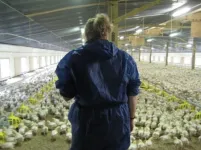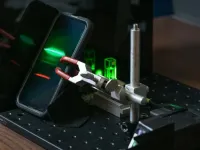(Press-News.org) Intensive livestock farming could raise the risk of new pandemics, researchers have warned.
Industrialised farming is often thought to reduce the risk of zoonotic diseases (those transmitted from animals to humans) because of better control, biosecurity and separation of livestock.
The new study, led by the University of Exeter, examines the effect of social and economic factors – which are often overlooked in traditional assessments.
It finds that the effects of intensifying agriculture “are at best uncertain and at worst may contribute to EID (emerging infectious disease) risk”.
Lead author Professor Steve Hinchliffe, from the University of Exeter, said: “The COVID-19 pandemic reignited interest in EIDs, especially zoonotic viruses.
“The risks of emergence and transmission depend on multiple factors, including contact between humans and animals, and how we use land.
“Livestock farming plays a potentially significant role in those risks, shaping landscapes and providing hosts that can act as the source or amplifiers of emerging pathogens.”
While such risks are usually assessed in terms of microbiological, ecological and veterinary sciences, the new study highlights the need to consider social, economic and political factors.
“Disease is always more than a matter of pathogen transmission, contact and contagion,” Professor Hinchliffe said.
“The founding myth in intensive farming is that we separate livestock from wildlife and thereby shut off the risk of diseases passing between them.
“But these farms exist in the real world – so buildings and fences can get damaged, wildlife like rats or wild birds can get in, and workers move around. In short, there will always be accidents.
“Once social, economic and political factors are taken into account, the pandemic risk posed by intensive farming is concerning.”
The paper highlights the expansion of intensive farming and the resulting environmental degradation as factors which can raise EID risks.
It also says intensification leads to a “mixed landscape” – with a variety of farming practices and types – which creates the “worst of all possible worlds in terms of EID risk”.
On biosecurity, the paper says some farm businesses find the costs “debilitating”, while regional variations also have an impact.
For example, European farm buildings can be old and costly to maintain, large US farms tend to be open-air concrete structures with netting (to avoid the need for air conditioning), and in subtropical areas biosecurity is balanced against the need to reduce overheating of animals.
“The result is a far from bio-contained environment,” the authors write.
They also note the close ties between large food companies and national authorities – which suggest “regulatory capture… and the difficulty of decoupling interests”.
Co-author Dr Kin Wing (Ray) Chan said: “Increasing on-farm biosecurity, standardisation, and efficiency in farm animal production is not the panacea for achieving a disease-free environment.
“Rather we need to reconsider the socio-cultural impacts of intensifying farm animal production on planetary health, environmental sustainability and animal welfare issues.”
The research team included Tufts University, Royal Agricultural University, University of Wollongong, Clark University, Cambridge Conservation Initiative and the Institute of Development Studies.
Funders included the Wellcome Centre for Cultures and Environments of Health and the Wellcome Trust.
The paper, published in the journal Royal Society Open Science, is entitled: “Understanding the roles of economy and society in the relative risks of zoonosis emergence from livestock.”
END
Intensive farming could raise risk of new pandemics
2024-07-17
ELSE PRESS RELEASES FROM THIS DATE:
Multiple concussions in rugby players change proteins linked to neurodegenerative diseases
2024-07-17
Retired rugby players who have suffered multiple concussions have higher levels of certain proteins in their blood, which may make them more prone to developing diseases such as motor neurone disease (MND), according to a new study.
The research, led by Durham University, shows that it may be possible to measure specific key biomarkers. These biomarkers can indicate disease or predict possible future disease in the blood of athletes who have suffered multiple traumas to the head.
This is the first study to explore a range of specific ...
Evening activity for better sleep – Otago study
2024-07-17
Rigorous exercise before bed has long been discouraged, but University of Otago researchers have found short bursts of light activity can lead to better sleep.
In a world first study, published in BMJ Open Sport & Exercise Medicine and funded by the Health Research Council, participants completed two four-hour evening intervention sessions of prolonged sitting, and sitting interrupted with three-minute activity breaks every half hour.
The researchers found that after the participants completed the activity breaks intervention they slept for 30 minutes longer.
Lead ...
More than 3,000 health care organizations recognized for commitment to high-quality cardiovascular care
2024-07-16
DALLAS, July 16, 2024 — Someone in the United States dies of cardiovascular disease (CVD) every 34 seconds, on average.[1] Reducing deaths from CVD requires a coordinated approach to care and a commitment to following science-based treatment guidelines.
The American Heart Association, celebrating 100 years of lifesaving service as a relentless force for a world of longer, healthier lives, is recognizing 3,147 health care and emergency response organizations for their commitment to improving health outcomes for cardiovascular patients through evidence-based efficient and coordinated care. ...
From lab to real life: innovative approaches to precision medicine
2024-07-16
Whether collaborating with the National Football League to study hamstring injuries, addressing the data gap in female musculoskeletal modeling research or simulating the effects of estrogen levels on muscle regeneration, biomedical engineering professor Silvia Salinas Blemker and her colleagues at the University of Virginia are pioneering health care advancements. In recognition of her outstanding work in translational research and entrepreneurship, Blemker received the 2024 Goel Award for Translational Research in Biomechanics from ...
UTA biologist wins national fellowship to study historic pollution
2024-07-16
A biology researcher at The University of Texas at Arlington has received a prestigious grant to continue and expand his research on how pollution affects wildlife.
Jordan Brown, a postdoctoral research associate in biology, was awarded a Postdoctoral Research Fellowship from the National Science Foundation’s (NSF) Directorate for Biological Sciences. The award supports researchers whose work focuses on how environmental changes affect animals.
Dr. Brown works in the lab of Shane DuBay, UTA assistant professor of biology, who studies evolutionary ecology, environmental science, and natural history to better understand the consequences of environmental change ...
Even on Instagram, teens mostly feel bored
2024-07-16
Concern that social media is driving the teen mental health crisis has risen to such a pitch that the majority of states in the country have filed lawsuits against Meta (which owns Instagram and Facebook) and the U.S. surgeon general called last month for warning labels on platforms, similar to those on tobacco.
New research from the University of Washington finds, though, that while some teens do experience negative feelings when using Instagram, the dominant feeling they have around the platform is boredom. They open the app because they’re bored. Then they sift through largely irrelevant content, mostly feeling bored, while seeking interesting bits to ...
UC Irvine’s electronic patient-reported outcome tool reduces cancer care disparities
2024-07-16
Irvine, Calif., July 15, 2024 — A University of California, Irvine research team has developed and implemented an intervention to enhance cancer care support services for racial and ethnic minority patients undergoing chemotherapy.
The electronic patient-reported outcome tool is a web-based application that allows individuals to enter their health data into a smartphone, tablet or computer. In this study, the ePRO was available in multiple languages and coupled with digital analytics. At each treatment visit, participants digitally ...
Research shows protein isoform inhibitors may hold the key to making opioids safer
2024-07-16
Researchers at the University of Arizona Health Sciences identified a new way to make opioids safer, increasing the pain-relieving properties of opioids while decreasing unwanted side effects through the spinal inhibition of a Heat shock protein 90 isoform.
Opioids are the gold standard of chronic pain treatment, but they come with a host of negative side effects including constipation, addiction potential and respiratory depression that can lead to death. This study, published in Scientific Reports, offers a potential new way to treat acute and chronic pain by reducing the amount of opioid needed for ...
Pocket-sized invention revolutionizes ability to detect harmful materials
2024-07-16
Imagine knowing what berry or mushroom is safe to eat during a hike or swiftly detecting pathogens in a hospital setting that would traditionally require days to identify.
Identification and detection of drugs, chemicals and biological molecules invisible to the human eye can be made possible through the combined technology of a cellphone camera and a Raman spectrometer — a powerful laser chemical analysis method.
Dr. Peter Rentzepis, a professor in the Department of Electrical and Computer Engineering at Texas A&M ...
A new addition to the CRISPR toolbox: Teaching the gene scissors to detect RNA
2024-07-16
Bacteria have developed special defense mechanisms to protect themselves against viruses, which by no means infect only humans. As part of these so-called CRISPR-Cas systems, a CRISPR ribonucleic acid (crRNA), which serves as a “guide RNA,” recognizes regions of a foreign genome, such as viral DNA. The CRISPR-associated (Cas) nuclease, directed by a crRNA, then renders it harmless by cutting it like a pair of scissors. Humans have exploited this strategy: “CRISPR, often referred to as ‘gene scissors’, is the basis of many molecular technologies,” says ...



